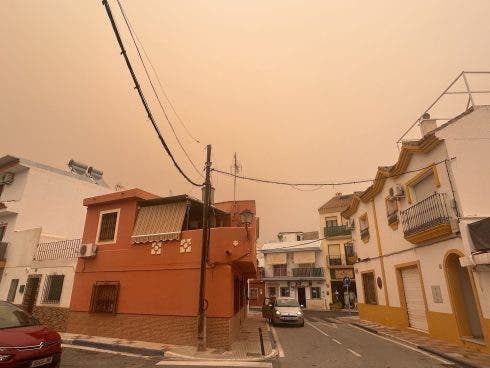THE skies above some parts of Spain have taken a red hue and the ‘blood rain’ gathers overhead – so just what is the fabled calima?
The calima has the remarkable effect of casting a reddish hue over the Spanish skies, and once the rain has settled it leaves a fine red coating over cars, streets and the land in general.
Sometimes inadequately translated as ‘haze’, it is a rare weather phenomenon marked by a dense concentration of dust, sand, and ash from the Sahara Desert trapped among rain clouds.
However, it can also be produced by less natural causes, such as the burning of fossil fuels, industry or agriculture.
Unlike fog, which consists of water droplets, the calima comprises solid particles which can travel vast distances carried by the wind.
It can also have the added effect of potentially altering local climate conditions by trapping heat in the atmosphere.
The origins of the calima are multifaceted, involving natural processes such as sandstorms in arid regions and volcanic eruptions, as well as human-induced factors from factories and agricultural activities.

The phenomenon is particularly notable in Spain’s Canary Islands but is not confined to desert areas alone; volcanic regions, agricultural and industrial zones, and areas prone to wildfires are also susceptible.
The presence of calima can have wide-ranging impacts, from health concerns – especially for those with pre-existing respiratory conditions – to environmental consequences.
The fine particles in the calima can infiltrate the lungs, leading to respiratory issues, while also affecting air quality and visibility, thus impacting outdoor activities and transportation.
Furthermore, the calima’s ability to retain heat in the lower atmosphere can lead to higher ground temperatures, affecting local weather patterns.
As this dust-laden air makes its way to Spain from the Sahara, understanding the nuances of the calima becomes paramount for residents and visitors in order to prepare and protect themselves.
Recognising the factors that contribute to its formation, the areas most affected, and the potential health and environmental implications is essential for local and health officials.
READ MORE:
- ‘Blood rain’ warning for Spain: DANA will bring the bizarre weather phenomenon this week, say experts – after their…
- ‘Blood rain’ latest: These are the 5 best methods for removing the red stains caused by the ‘calima’ –…
- ‘Blood rain’ is coming to Spain: New DANA will bring the weather phenomenon to Andalucia and beyond this week
Click here to read more News from The Olive Press.








